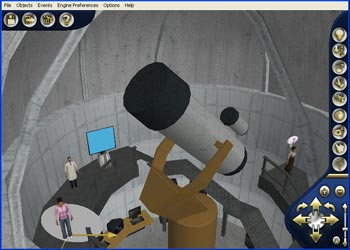Online games spark girls' interests in science & technology
| 15 May 2009
 In
the online virtual world of "Universe Quest," young
girls can create characters that interact with
one another and operate a virtual telescope as
if it were real, obtaining actual images through
a small telescope in Arizona. (UC
Berkeley image)
In
the online virtual world of "Universe Quest," young
girls can create characters that interact with
one another and operate a virtual telescope as
if it were real, obtaining actual images through
a small telescope in Arizona. (UC
Berkeley image)BERKELEY — Ruby Knight and Tiffany Farmer, sixth and seventh grade Girl Scouts at the ASA Academy in West Oakland, have never met Susan Murabona, an educator and astronomer in Nairobi, Kenya. Nor have they visited the Ironwood North Observatory (INO) in Queen Creek, Ariz., or talked to Lech Mankiewicz, an astrophysicist in Warsaw, Poland.
But Ruby, Tiffany, Susan and Lech all got together via the Internet earlier this month to begin assembling an online game that will help girls around the world explore the cosmos and perhaps steer them toward careers in software development and information technology.
"The Universe Quest Game," an immersive game similar to the popular multi-user virtual world called "Second Life," is being made possible by a $1.5 million grant from the National Science Foundation (NSF) to the University of California, Berkeley.
"Girls have traditionally been left out of the pipeline to technology careers, and African Americans as well, and there is a strong sense that we need to reach these very talented populations," said Carl Pennypacker, UC Berkeley principal investigator of the "Universe Quest" project. "We know we can inspire the students, and we know from research that inspired children learn more and achieve more."
"These children are beginning to have some of the most profound, powerful and useful educational experiences that we can provide," said colleague Hakeem Oluseyi, a Florida Institute of Technology professor and former UC Berkeley scientist who is helping coordinate the after-school class producing the game.
When they met online recently, the girls poured over images of the galaxy M51, a collection of stars about 35 million light years from our own galaxy. The images were taken by Murabona from her lab in Kenya using the remote INO telescope in Arizona.
From his home in Warsaw, Mankiewicz coached Murabana, taking her step by step through the intricacies of using the telescope and acquiring images. Murabona then taught the girls to use a free French software program known as SalsaJ to combine three images, taken with red, green, and blue filters, to make a true color image of the galaxy.
 Ruby
Knight and Tiffany Farmer videoconference with astronomer Susan
Murabona in Nairobi, Kenya, to learn how to remotely operate a
telescope in Arizona. (Carl Pennypacker/UC
Berkeley)
Ruby
Knight and Tiffany Farmer videoconference with astronomer Susan
Murabona in Nairobi, Kenya, to learn how to remotely operate a
telescope in Arizona. (Carl Pennypacker/UC
Berkeley)The M51 images will become part of "The Universe Quest Game" that the Oakland Girl Scouts will build and populate to learn about astronomy while interacting with other students from around the world, who will be creating their own games and journeys. Ninety girls from Kenya High in Nairobi, for example, are eagerly awaiting the chance to play Tiffany's and Ruby's games, and also to create their own games and share them with the ASA girls.
In the process, the students all will learn how to use remote telescopes, process images, search databases and discover and monitor such astronomical puzzles as quasar variability. They will even be able to find and name their own asteroids.
"It is widely believed that serious gaming technology could prove to be of value in formal and informal education," said Pennypacker. "We are at the edge of this research, and trying to find a way to make it succeed. And so far, it is succeeding - the girls are making great games, they're engaged, they are enthusiastic, they are learning things. It is a breakthrough for the girls and me and, hopefully, society."
For the girls, authoring an online immersive game, creating characters and providing them with personalities and questions to ask other players, has proved seductive.
"I think it is fantastic that girls our age get to make a game," said seventh grader Tiffany.
"I would like to see other people around the world playing the games we made," added Ruby, a sixth grader.
"It's amazing how the girls are captivated by game authoring," Pennypacker said. "People say that kids like games, but it is extraordinary how they become engaged. They really like the detailed creative part of game authoring, not the shoot-'em-ups like 'World of Warcraft.'"
So far, a dozen girls meet to work on the game two afternoons a week for two hours at the ASA Academy & Community Science Center, a small, urban, hands-on school that helps traditionally underrepresented youth prepare to move into the ever-changing scientific and technological world. The 3-D online environment the girls are now constructing will eventually be open to girls around the world to explore and build upon.
The three-year grant from NSF's Innovative Technology Experiences for Students and Teachers (ITEST) program was the result of a strong collaboration between the ASA Academy, the Girl Scouts of Northern California, and UC Berkeley's Space Sciences Laboratory (SSL), according to Pennypacker, who has a position at both SSL and Lawrence Berkeley National Laboratory. Now in the pilot stage, Pennypacker and his colleagues hope to expand the program to 30 or more girls from Oakland, El Cerrito and Richmond before offering it to teachers around the world.
Ironwood North Observatory, which consists of a 10-inch telescope operated by amateur astronomer Frank Pino, delivers more than 1,000 images a month to students all over the world. Many of these students are participants in Hands-On Universe, an international education program started by Pennypacker more than a decade ago and centered at UC Berkeley's Lawrence Hall of Science.

